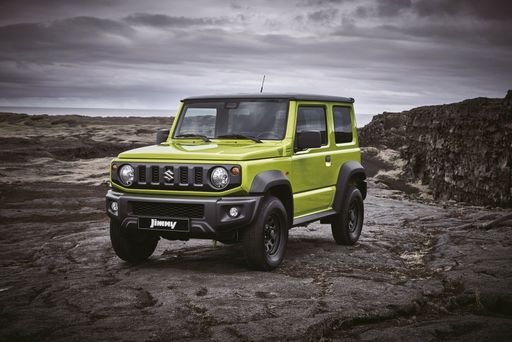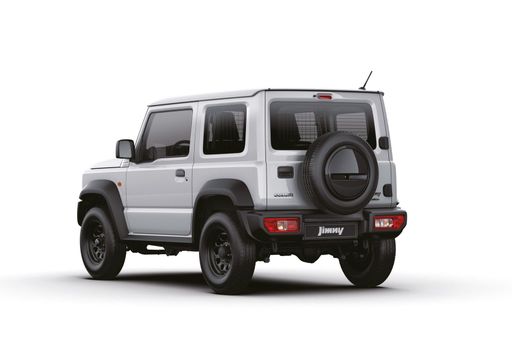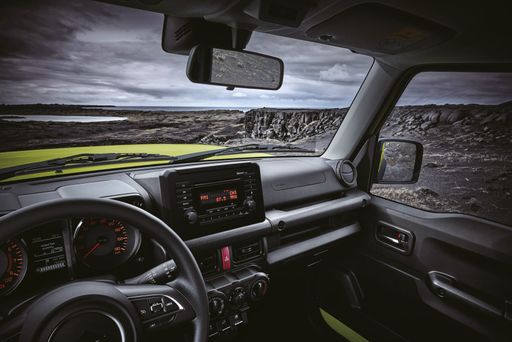Mercedes Sprinter Bus VS Suzuki Jimny – Specs, Efficiency & Price Comparison
Which model is the better choice – the Mercedes Sprinter Bus or the Suzuki Jimny? We compare performance (190 HP vs 102 HP), boot capacity ( vs ), efficiency (9.30 L vs 7.70 L), and of course, the price (41400 £ vs 25300 £).
Find out now which car fits your needs better!
The Mercedes Sprinter Bus (Bus) is powered by a Diesel engine and comes with a Manuel or Automatic transmission. In comparison, the Suzuki Jimny (Off-Roader) features a Petrol engine and a Manuel gearbox.
When it comes to boot capacity, the Mercedes Sprinter Bus offers , while the Suzuki Jimny provides – depending on what matters most to you. If you’re looking for more power, you’ll need to decide whether the 190 HP of the Mercedes Sprinter Bus or the 102 HP of the Suzuki Jimny suits your needs better.
There are also differences in efficiency: 9.30 L vs 7.70 L. In terms of price, the Mercedes Sprinter Bus starts at 41400 £, while the Suzuki Jimny is available from 25300 £.
Compare all the key specs now and find out which model fits your lifestyle best!
Mercedes Sprinter Bus
The Mercedes-Benz Sprinter Bus stands out as a versatile option for those seeking both comfort and practicality in a people mover. Its spacious interior design ensures ample room for passengers while maintaining a smooth and efficient driving experience. With its advanced safety features and modern amenities, the Sprinter Bus continues to be a leader in its class.
detailsSuzuki Jimny
The Suzuki Jimny is a compact SUV that has gained a loyal following for its rugged charm and off-road capabilities. Its boxy design is both nostalgic and functional, making it stand out in a sea of more streamlined vehicles. Despite its small size, the Jimny offers a surprisingly robust driving experience, ideal for adventurous journeys off the beaten track.
details @ suzuki.at
@ suzuki.at
 @ suzuki.at
@ suzuki.at
 @ suzuki.at
@ suzuki.at
 @ suzuki.at
@ suzuki.at

|
|
|
|
|
Costs and Consumption |
|
|---|---|
|
Price
41400 - 55900 £
|
Price
25300 - 27700 £
|
|
Consumption L/100km
9.3 - 12.3 L
|
Consumption L/100km
7.70 L
|
|
Consumption kWh/100km
-
|
Consumption kWh/100km
-
|
|
Electric Range
-
|
Electric Range
-
|
|
Battery Capacity
-
|
Battery Capacity
-
|
|
co2
244 - 322 g/km
|
co2
173 g/km
|
|
Fuel tank capacity
71 L
|
Fuel tank capacity
40 L
|
Dimensions and Body |
|
|---|---|
|
Body Type
Bus
|
Body Type
Off-Roader
|
|
Seats
2
|
Seats
2
|
|
Doors
4
|
Doors
3
|
|
Curb weight
2356 - 2559 kg
|
Curb weight
1165 kg
|
|
Trunk capacity
-
|
Trunk capacity
-
|
|
Length
5932 - 6967 mm
|
Length
3645 mm
|
|
Width
1993 mm
|
Width
1645 mm
|
|
Height
2633 - 2659 mm
|
Height
1705 mm
|
|
Payload
814 - 1144 kg
|
Payload
270 kg
|
Engine and Performance |
|
|---|---|
|
Engine Type
Diesel
|
Engine Type
Petrol
|
|
Transmission
Manuel, Automatic
|
Transmission
Manuel
|
|
Transmission Detail
Schaltgetriebe, Automatikgetriebe
|
Transmission Detail
Manual Gearbox
|
|
Drive Type
Rear-Wheel Drive, All-Wheel Drive
|
Drive Type
All-Wheel Drive
|
|
Power HP
114 - 190 HP
|
Power HP
102 HP
|
|
Acceleration 0-100km/h
-
|
Acceleration 0-100km/h
12.80 s
|
|
Max Speed
150 - 159 km/h
|
Max Speed
145 km/h
|
|
Torque
300 - 450 Nm
|
Torque
130 Nm
|
|
Number of Cylinders
4
|
Number of Cylinders
4
|
|
Power kW
84 - 140 kW
|
Power kW
75 kW
|
|
Engine capacity
1950 cm3
|
Engine capacity
1462 cm3
|
General |
|
|---|---|
|
Model Year
2024 - 2025
|
Model Year
2021 - 2024
|
|
CO2 Efficiency Class
G
|
CO2 Efficiency Class
F
|
|
Brand
Mercedes-Benz
|
Brand
Suzuki
|
Mercedes Sprinter Bus
The Mercedes-Benz Sprinter Bus: A Revolution in Transport
The Mercedes-Benz Sprinter Bus has long been a symbol of efficiency and reliability. Renowned for its versatility and performance, Mercedes-Benz continues to push boundaries with its latest models, catering to the needs of businesses and individuals alike. Whether used for passenger transport or as a corporate shuttle, the Sprinter Bus offers an exceptional driving experience, combining innovative technology with superior comfort.
Engineering Excellence: Under the Bonnet
At the heart of the Mercedes-Benz Sprinter Bus is its robust engine lineup, offering power outputs ranging from 114 PS to an impressive 190 PS. These variants ensure that there is a model suitable for every requirement, whether you need efficient city commuting or robust highway cruising.
The Sprinter Bus is equipped with either a manual or automatic transmission, providing flexibility to suit different driving preferences. The sophisticated 9G-TRONIC automatic gearbox represents a pinnacle of automotive engineering, ensuring smooth and efficient gear changes, which enhance the overall driving experience.
Performance and Efficiency: Meeting Environmental Standards
The Sprinter Bus's diesel engines are not just about power; they also focus on fuel efficiency, with consumption figures between 9.3 L/100km and 12.3 L/100km. The inclusion of start/stop technology helps in reducing fuel consumption, thus making it more economical and environmentally friendly.
Mercedes-Benz shows its commitment to sustainability by ensuring all engine options comply with stringent emissions standards. The models provide a CO2 efficiency class of G, underlining the brand's dedication to creating vehicles that are as kind to the planet as they are to your pocket.
Design and Comfort: Where Function Meets Style
The design of the Mercedes-Benz Sprinter Bus effortlessly combines functionality with aesthetics. The interior space is crafted to provide maximum comfort for passengers, while the exterior design leaves a lasting impression with its sleek lines and authoritative presence.
The Sprinter Bus can accommodate up to nine seats, making it ideal for passenger transport. Options such as air conditioning, advanced infotainment systems, and ergonomic seating ensure a pleasant experience for both driver and passengers, even on long journeys.
Safety and Technology: Prioritising Your Well-being
The Sprinter Bus offers a suite of advanced safety features aimed at keeping occupants safe, including adaptive cruise control, lane keep assist, and crosswind assist. These features are integrated with cutting-edge technology, such as the Mercedes-Benz User Experience (MBUX) system, which enhances connectivity and user interaction.
With rear-wheel drive and optional all-wheel drive capabilities, the Sprinter Bus is equipped to handle a variety of terrains and weather conditions, providing reassurance for every journey.
The Future of Transport: Innovative Options
Mercedes-Benz demonstrates their innovative edge with customisation options tailored to various business needs, be it for luxury transport or robust utility. Additionally, the Sprinter Bus's load capacity ranges from 814 kg to 1,249 kg, ensuring businesses can meet their logistical needs efficiently.
As demands for sustainable transport solutions grow, the Sprinter Bus is positioned as a forward-looking vehicle that blends traditional Mercedes-Benz quality with modern innovations.
The Mercedes-Benz Sprinter Bus is more than just a vehicle; it is an investment in exceptional performance and unmatched adaptability, engineered to meet the diverse demands of today's transport sector. From its powerful yet efficient engines to its state-of-the-art technology and safety features, the Sprinter remains a leader in its class.
Suzuki Jimny
Revamping Tradition with Modern Twists: The Suzuki Jimny
The Suzuki Jimny continues its legacy as a robust compact off-roader, seamlessly blending its iconic design with modern technological advancements. Whether traversing rugged terrains or cruising urban streets, the Jimny stands out as a versatile companion.
A Legacy Reimagined: Design and Build
Suzuki stays true to its roots with the Jimny's classic square silhouette. This three-door compact SUV is not just about aesthetics; its dimensions—with a length of 3645 mm, a width of 1645 mm, and a height of 1705 mm—are designed to tackle off-road challenges effortlessly. With its compact build, the Jimny fits snugly into city parking spots whilst still radiating an aura of toughness.
The Heart of the Machine: Engine and Performance
Powered by a 1.5-litre four-cylinder engine, the Jimny delivers 102 PS and 130 Nm of torque. Its petrol engine is paired with a manual transmission, offering drivers a more connected and tactile driving experience. With a fuel consumption of 7.7 L/100km, it strives to balance power and efficiency. The Jimny's maximum speed peaks at 145 km/h, while it accelerates from 0 to 100 km/h in 12.8 seconds, a testament to its steadfast performance in its category.
Mastering Terrains with ALLGRIP PRO
One of the standout features of the Jimny is its ALLGRIP PRO all-wheel-drive system, designed for serious off-roaders. This technology provides the driver with the ability to switch between 2WD and 4WD at the flick of a switch, ensuring maximum traction no matter the condition. The elevation of its chassis and its tough underbody protection mean the Jimny can handle rough landscapes with relative ease.
Comfort Meets Functionality: Interior Features
Step inside, and you'll find an interior that perfectly balances utility and comfort. The Jimny might be a two-seater, but its thoughtful design ensures ample space for both driver and passenger. The dashboard is simple yet functional, equipped with essential features that accentuate the driving experience without unnecessary distractions.
The Green Concerns: Environmental Impact
While the Jimny offers impressive off-road capabilities, its CO2 emissions stand at 173 g/km, placing it within efficiency class F. This is an area where environmentally conscious buyers might seek further innovation from Suzuki. Despite this, the Jimny remains a preferable choice for those who value performance over emission metrics.
Balancing Act: Cost and Affordability
Priced between €29,490 and €32,340, the Jimny positions itself within a competitive market segment. Potential owners will be making a modest investment for a vehicle that promises both durability and versatility. With monthly costs estimated at €940 and €0.376 per kilometre, it remains an affordable option for those who prioritise capability over luxury.
In Conclusion: A Symbol of Reliability
The Suzuki Jimny is more than just a car; it’s a lifestyle choice for adventurers who refuse to conform to the ordinary. With years of trust behind it, the Jimny has successfully adapted to the needs of the modern driver without compromising its rugged essence. Whether you're scaling new heights or navigating city landscapes, the Jimny proves itself a worthy companion on any road less travelled.
The prices and data displayed are estimates based on German list prices and may vary by country. This information is not legally binding.
